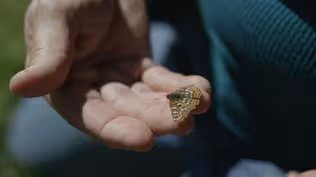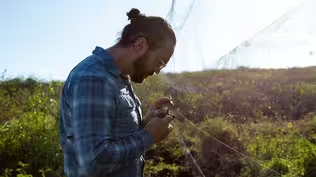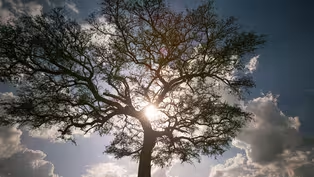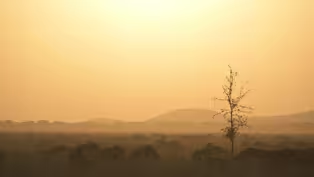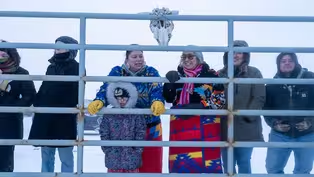
Grasslands
Episode 5 | 55m 5sVideo has Closed Captions
Forgotten and overlooked, grasslands could hold the key to our planet’s survival.
Grasslands are one of the planet’s most important, yet most overlooked habitats. Follow scientists as they discover animal species with the power to transform and restore our grasslands, turning them into carbon sinks that could slow climate change.
Problems playing video? | Closed Captioning Feedback
Problems playing video? | Closed Captioning Feedback

Grasslands
Episode 5 | 55m 5sVideo has Closed Captions
Grasslands are one of the planet’s most important, yet most overlooked habitats. Follow scientists as they discover animal species with the power to transform and restore our grasslands, turning them into carbon sinks that could slow climate change.
Problems playing video? | Closed Captioning Feedback
How to Watch Evolution Earth
Evolution Earth is available to stream on pbs.org and the free PBS App, available on iPhone, Apple TV, Android TV, Android smartphones, Amazon Fire TV, Amazon Fire Tablet, Roku, Samsung Smart TV, and Vizio.
Buy Now

Evolution Earth
Traveling to the far corners of the world, we discover the extraordinary ways animals are adapting to our rapidly changing planet. We witness nature’s remarkable resilience, as our perception of evolution and its potential is forever transformed. Read these interviews with experts to learn more.Providing Support for PBS.org
Learn Moreabout PBS online sponsorship♪ [Shane Campbell-Staton] Grasslands.
Forgotten, overlooked... but if you look a little closer... dig a little deeper, you'll discover a wondrous hidden power... a force of nature that can conjure the greatest gathering of life on Earth... and maybe, just maybe, heal our planet.
[singing in indigenous language] It might be hard to believe, but this is hard science, a new understanding that with just the right combination of elements and animals we can unleash a power that can alter the very fabric of the Earth.
♪ ♪ [thunder rumbling] ♪ My name's Shane Campbell-Staton.
I'm an evolutionary biologist.
I'm here to tell you stories from filmmakers, scientists, and local experts across the globe about a pulse of change.
The entire planet is shifting.
The climate is changing at an incredible 170 times faster than it should be.
We can't always see it, we're so caught up in our own thing, you know, but the signs are everywhere.
♪ The entire tree of life is whispering to us.
We just have to pay attention.
Out there, things aren't what you expect.
You'll see.
[mewing] [birds chirping] In this series, we followed how animals are adapting to our changing world, but for this episode... we got sidetracked.
This time... it wasn't the animals transforming.
It was the land itself.
♪ The shift in our thinking started while we were filming a story in the Serengeti, a story that was set in motion 60 years ago when vets eradicated a disease that wildebeest were catching from cattle.
Scientists observing the wildebeest watched as the population exploded.
♪ They rose and rose from 300,000 animals to over a million in less than 20 years.
♪ No one saw it coming.
At the time, people got so worried, there were even calls to cull the wildebeest.
They thought these giant herds would turn the Serengeti to dust... ♪ [thunder rumbling] and the land did change.
♪ It became greener.
[lowing] Where the wildebeest grazed, trees grew where they hadn't grown before.
The Serengeti supported more animals, not less.
The herds of wildebeest moved across the landscape, transforming the ecosystem.
It was extraordinary!
♪ Yeah.
The story is a bit more complicated.
Maybe I can say something about the dung, as well?
Yeah.
[Shane] I think it's best to hand it over to Inger de Jonge.
She's a grassland ecologist and she knows her... uh, stuff.
[Inger] A lot of wildebeest also means a lot of dung, and a lot of dung means a lot of dung beetles... and dung beetles make these nice round balls, and they actually incorporate that inside soils.
[Shane] We need to take a moment here to really appreciate just what these little guys can do.
He pushes up to 50 times his own body weight.
He will roll his stash for over 600 feet, looking for just the right soft soil to store his treasure.
For us, that's like pushing a compact car for nearly 9 miles.
Why does he do it?
The dung balls are going to be food and a nursery for the females' larvae... and it turns out this paternal moment has a much more important effect on the plains than we first thought.
Incredibly, nearly 20% of all the soil in the Serengeti is buried dung balls.
That's a lot of poop!
[Inger] It really enriches the soil of the Serengeti.
[Shane] So it's basically the perfect fertilizer.
[Inger] This has an huge impact on our vegetation composition and vegetation structure.
Inger's research is focusing on what all this means for the Serengeti.
[Inger] We're looking at how much nutrients there are in soils, how much organic matter.
So they're extremely rich, and this really supports very nutritious grasses.
[Shane] And I mean a ton of them.
I don't really know how many grass species there are in the Serengeti, but we know of at least 80 of them, but I'm sure there are more.
They basically support all the wildlife species.
[lowing] [Shane] You can't help but look at the role of the wildebeest with fresh eyes.
♪ Tag-teaming with these little beetles, they aren't bulldozers.
They're regeneration machines.
Wildebeest actually has an huge effect on the ecosystem.
[Shane] We're only now coming to appreciate the true power of this effect... [thunder rumbling] how this machine of nature works.
[rain falling] ♪ Millions of animals... following the rains... are joined by billions of insects... [thunder rumbling] triggering a transformation of the Earth... ♪ but there is one more secret hidden in the soil that I think you're gonna want to hear.
[Inger] Because of all this grazing by wildebeest and because of all these dung beetles... [Shane] The combined effect of these animals... [Inger] all this wildlife... [Shane] is creating something else.
[Inger] the Serengeti is a very important carbon sink.
[Shane] A healthy savanna can absorb the CO2 from our atmosphere.
[Inger] We start to understand now that grasslands play a major role in fighting climate change.
[Shane] In a world that needs healing, this is important stuff.
[wildebeest lowing] Inger believes grasslands have a potential we are only just understanding, but just as we begin to see their importance, they are disappearing before our very eyes.
We have lost half of all grasslands across the world, and most of those that remain are shadows of their former selves, ghost habitats.
Even in places as remote as the plains of Patagonia, grasslands have become denuded.
♪ For over a century this place was taken over by sheep farmers.
The land was enclosed to allow their flocks to graze and graze... leaving the land dry and dusty.
Even grazing sheep became difficult, and farms were abandoned.
Here in Patagonia, they've tried something new, tearing down the fences, closing the few remaining farms, and returning the land to wilderness.
♪ Herds of guanaco soon moved in, free to reclaim these plains.
♪ A dominant male guarding a harem of over 30 females.
He likes to gather them together, keeping them grazing close by, where he can keep an eye on them... ♪ always on the lookout for a young buck sneaking in.
[guanaco braying] The younger animal has been spotted, but he ain't backing down.
[braying] [grunting] [grunting] [braying] ♪ Guanacos are so much more gangsta than I thought they were.
"Yeah, that's what I thought, punk.
Go on now and tell your friends about me!"
Ha ha ha!
♪ Guanacos are famously chill.
They don't want to move if they don't have to.
Some might say living the good life.
While they were thriving, what was clear pretty quick was that most of these grasslands were not faring much better than when the sheep were here.
The hoped-for recovery had not happened... but in a few places, something has started to change.
From Chile to Argentina, reports have been coming in of a regeneration... a greening effect spilling down on to the plains.
♪ To get to the bottom of what could possibly be driving this regeneration, we needed to enlist the services of someone who has a unique perspective on the landscape.
This dude's been around long enough to remember what it was like before.
Claro.
Diferente.
Ya no es lo mismo.
[horse nickering] Yo me llamo Arcilio Sepulveda.
[Shane] Arcilio's a man of few words.
[Woman] ¿Tienen que tapar?
¿Entonces usted tiene que tapar el lado derecho siempre?
No importa que no esté tapado porque me da lo mismo porque no veo con ese ojo.
[Shane] He may only have one good eye, but he knows what he's looking for.
♪ [Shane] Arcilio was once a leonero, employed by the sheep farms to hunt mountain lion, or puma as they call them here.
[static crackling] Today, he's employed to track them.
[beeping] Pumas became elusive and cautious following years of hunting... ghost animals in a ghost habitat you might say... ♪ but if anyone knows where to find them, it's Arcilio.
[Arcilio] Ahi, la vista con el puma!
But what happens next was way beyond even Arcilio's expectation.
De que veo un cachorro chiquitito.
♪ [mewing] La única vez de los años en que ando así en el puma.
♪ [Shane] This is the first time newborn puma cubs have ever been filmed in the wild here.
♪ To have a mother basking in the sun with her two cubs in this way, it's a clue to what's changing in Patagonia.
♪ I'm not a huge cat person honestly, but, I mean, adorable is adorable.
[mewing] ♪ The relaxed nature of the puma, no longer hiding away in the hills, is key to the transformation of the land.
♪ [cub mewing] [thunder rumbling] ♪ Now no longer hunted by the likes of Arcilio, no longer persecuted... [panting] the pumas are coming down from the mountains onto the plains... ♪ and with them comes fear.
♪ The young male guanaco has been chased off from the group.
Alone, he's easier to sneak up on.
♪ ♪ At the last second, he spots her.
[braying] The herd is spooked, and the chase is on!
[guanaco yelping] [puma snarling] Get off the track when the train's coming through.
[guanaco braying] ♪ [braying] [braying] Only about 1 in 5 hunts is successful, but just the presence of a predator like this can change the behavior of all the guanacos.
[braying] Scientists call it an ecology of fear.
The guanacos no longer stay put, overgrazing in just one spot.
The fear keeps them moving.
♪ Like the wildebeest of the Serengeti, they are now grazing larger areas, churning up the soil, and it's this return of an ancient rhythm between the animals and the plants that is having this startling effect on the landscape, causing the grasslands to return.
I can't overstate how big an effect the pumas are having here.
It's not just the grass that is transformed but the whole ecosystem.
Even a single kill, when they pull it off, causes a cascade of events that feeds this system.
These kills are way more than they can eat in one sitting.
They'll stash the rest for later... and it's estimated that over 200 species feed upon the pumas' half-eaten carcasses.
It's clear to see how all this life and regeneration is so interconnected, and now, we're identifying that there are keystone species like the puma.
Their presence and behavior are essential for making the grasslands flourish.
♪ The potential for animals to resurrect ghost habitats has only recently been truly understood... but what about our grasslands closer to home... ♪ in our own backyard?
♪ Grasslands are where we humans once gathered.
They're where our civilizations were created.
Here, they've become the breadbasket of America.
Not surprisingly, over half of America's grasslands have been turned over to agriculture, but has the industrialization of these plains reached unsustainable levels?
Have we gone too far?
Today, only a few pockets of original prairie remain, yet we're discovering places like these have extraordinary potential.
They are rich.... [chirping] diverse... [buzzing] and teeming with life... places we really can't afford to lose.
[Camille Parmesan] So What's astonishing to me is that the public really doesn't know anything about grasslands, and yet to ecologists, grasslands are, like, so exciting and fundamentally important, and it's so obvious we need to preserve grasslands.
♪ It--it just gives you a feeling of awe and magic.
[Mike] Agh.
[Camille] OK.
Hang on.
Give me a minute.
Can you get out your butterfly net?
Oh!
I need to put a new net back on.
Hang on.
[Shane] Of all the people I've talked to in this series, there's one woman who inspires me most to understand our planet by looking to the animals... Oh, Michael, did you put this on?
Ha ha ha!
Michael, come here.
[Shane] Camille Parmesan.
Y chromosome.
[Shane] She likes nothing better than hanging out in the grass, where she and her husband Mike catch butterflies... -Ah.
Here's the butterfly -Where?
Ah, hello!
There you go.
Didn't get it.
[Shane] or try to.
There's another one.
[Camille] I lost her.
Do you see her?
God, too fast.
Yeah.
There's two there.
Two there.
Here.
Take-- here, here.
[Shane] It looks like fun... She did manage to make a clean break.
[Shane] but it's serious work... 40 years of it... [Camille] Ah!
[Shane] trying to understand the powerful connection between the land and our animals.
Yay!
[Camille] Yeah.
[Mike] All right.
Oh.
How cool.
[Shane] This little butterfly in particular has proved for her to be an excellent sentinel in our modern world.
♪ They really do give you enormous amounts of data, so you can ask them very complex questions, and they answer you.
So it's absolutely a brilliant system to be doing the kind of studies we're doing, and they're turning out also to be our first warnings that the world is changing massively!
That's probably way too long an answer.
Sorry.
When you get me on my butterflies... [Shane] Trust me.
I get it.
One butterfly more than any other is sounding the alarm about this vanishing ecosystem.
♪ This little caterpillar munching away is gorging on the one plant in the prairie that he can eat... milkweed.
The plant is toxic to most animals but not this little dude.
He is voracious.
♪ He's getting ready to transform... and become one of the most beloved insects in America... ♪ the monarch butterfly.
Now, you might think that their dazzling orange wings would make them pretty easy targets for predators, but the milkweed takes care of that.
[Camille] The plants are toxic.
They use that chemistry, they sequester it into themselves.
Then they become toxic so birds don't eat them and fly on to the next population.
[Shane] A perfect symbiotic relationship... but it's under threat.
More of the land is going under agriculture, so the milkweed is declining, and the remaining milkweed is next to a cornfield that has pesticides flowing onto the milkweed.
The survival of the caterpillars really declines.
[Shane] While making this film, these butterflies were classified for the first time as endangered with extinction, and this is not an isolated story.
[Camille] We're losing mosquitoes and dragonflies and butterflies and beetles and hoverflies and everything else, and we're seeing it globally.
[Shane] More and more of our grasslands are disappearing.
Our industrialized farming methods are changing the world so fast and on such a scale we are in danger of losing an entire ecosystem, and unsustainable methods are contributing to the warming of our planet.
You got to wonder if our diminished grasslands could have the potential to be transformed into something else like in South America and Africa.
Well, it's worth remembering that back in the day there were vast herds of animals here even larger than those found in the Serengeti.
♪ Two centuries ago, bison ruled the American prairie.
[bison grunting] A herd of up to 60 million animals roamed a grassland almost 200 times larger than the Serengeti... [bison grunting and snorting] but that was a long time ago before European settlers wiped them off the land.
Now, there are very few places where bison still roam.
♪ ♪ This male just turned 6 years old.
It's time for him to step in the ring and prove himself for the right to mate.
It's time for him to join the rut.
Aw, it's time to get down with the big boys now.
♪ The big man wallows in the dirt, raising plumes of dust to draw attention to himself... and it seems to have worked.
[grunting] ♪ A well-placed stab from those horns could be lethal.
♪ If he loses a fight to one male, well, he'll just challenge another.
In this way, the fighting goes on for days, even months.
This time, this poor dude has failed to win the right to mate.
Maybe next year, homie!
Exhausted and injured, he limps away.
If he can't restore his energy reserves before winter hits, a young bull like this can die... but following an ancient instinct of survival, he heads across the plains... in search of a special place... somewhere with rich, diverse grass that can help him build back his strength because the bison knows better than us about the importance of this small rodent, the prairie dog.
It's one of the strangest and cutest relationships on the prairie and all the more poignant because, like the bison, these little critters were also killed by the millions.
The prairie dog colonies are just what the bison is looking for to help his recovery... because here there are the lushest grasses, giving him vital energy when he needs it the most.
♪ [grunting] [prairie dog chirping] [squealing] The bison's journey to this place is also showing us the amazing affect prairie dogs can have on revitalizing grasslands, helping return a landscape that had almost been forgotten... [chirping] but it takes work!
These prairie dogs, they put in the hours.
These guys are skilled and tireless gardeners... always digging away, working on their network of tunnels that can run for miles and miles.
This churns and ploughs the earth, bringing vital nutrients to the surface.
♪ When they pop up above ground, they prune and crop the vegetation more precisely than any hefty bison... which is pretty important because when you're this size you're kind of a perfect snack for a bunch of predators, so you need to have your view clear to see when danger's coming.
[squealing] [chirping] The bison help out, too, donating their dung and urine to enrich the soil.
[grunting] It's an unusual marriage... but it works.
The surrounding grassland becomes a green oasis.
Prairie dog towns are islands of life for other grassland species that have almost vanished from these plains.
Their burrows provide homes for cottontail rabbits and burrowing owls.
Rattlesnakes and toads move in, too... [croaking] and salamanders and deer mice.
♪ This story of transformation doesn't stop here.
Researchers are discovering that bison, like the wildebeest on the Serengeti, are transforming our grasslands in ways never expected.
♪ Here in Minnesota, studies on one of the last few remaining herds of bison are revealing how bison can affect the growth of trees.
[bison grunting] Suddenly, oaks are appearing... not in a forest but spread out amongst the grasslands.
These trees need the bison to clear the tall grasses away, preventing fires taking hold and helping their saplings reach maturity.
Once, this kind of oak savanna stretched throughout the Midwest.
Today, only 0.02% of it remains... and with the oaks come animals rarely seen in decades like red-headed woodpeckers.
♪ [bison grunting] Even here in the U.S., the right balance of animals set in motion a powerful force... to resurrect a ghost habitat.
and create a Serengeti at home.
When you see it and it all fits together, it seems so simple, but in our ever-changing world, nothing sits still for long.
Just as we think we get how this ecosystem works, nature throws us a curve ball.
Recently, researchers studying one of the smaller critters on the prairie stumbled upon something odd, a change that would ultimately lead to a new understanding about the importance of these places, an appreciation that could have major implications for our future.
♪ There are 11,000 species of grasshopper.
They are intimately connected to the grassy plains.
I mean, hence grasshopper.
They're found in every grassland on the planet, and their munching stimulates the grass to grow.
They can eat more than twice their body weight in a day... but very recently, researchers in Kansas-- the kind of people who keep tabs on how hoppers like this are getting along in the world-- well, they noticed something seemed wrong.
Grasshopper populations were plummeting.
Even though they have plenty of grass to eat, they're dying, and there are no obvious clues as to why.
Turning detective, the researchers are casting the net wider, and our changing climate is the chief suspect.
♪ Scientists are forensically analyzing the grass itself.
♪ This experiment, it's like a time machine because it can simulate how our atmosphere is changing now, as well as in the future.
♪ Pumping a different concentration of CO2 onto each plot, they're finding that the grass is responding to increased carbon dioxide much more dynamically than they expected.
The plants absorb the extra CO2, doubling in biomass, but other nutrients like calcium, potassium, zinc, and iron are being diminished by as much as 90%!
It may look all lush and nutritious, but, like some breakfast cereals I could mention, it's like feeding on cardboard.
[munching] It's only now that we're clocking the extent to which our plant life is reacting to our changing planet... and running with this new understanding, some folks are looking to our grasslands with a new excitement.
[shovel scraping earth] Jane Zelikova is one of those people.
[Jane] There we go.
Nice.
Wow!
Look at that.
[Shane] Jane believes grasslands could be our greatest weapon of defense against climate change.
Once again, the secret is in the soil.
[Jane] Oh!
I love it.
I just want to keep touching it.
[Shane] Jane is a connoisseur.
Full of body, oaky, grassy tones.
Like the way people describe wine, like, I think we could talk about soil that way.
You should put it in a bottle.
People should have a chance to be able to, like, put this in their house and have it smell like this.
So we're lifting up!
[Shane] Not everyone is quite as excited by soil as Jane.
[Jane] Let's get this soil.
[woman] Ready?
She's been traveling across the country, digging holes and analyzing the soil composition in the few remaining undisturbed grasslands.
[Jane] Here she comes!
Here she comes!
Look at how dark it is.
Oh, there she is!
That's really good.
Look at that!
Beautiful!
These are kind of the magical soils that you dream of.
[Shane] She ain't wrong.
They really are something special.
[Jane] It's basically black all the way down.
So dark soil like this probably tells us there's a lot of organic matter in here.
[Shane] This is premium stuff!
[Jane] Ah, man!
The roots here are just prolifically insane.
Like, they're just abundant and deep and... hairy.
What we see above ground is just a small portion of all the biomass.
[Shane] The blades of grass we all see really are just the tip of the iceberg.
[Jane] Actually, the bulk of it is below ground in these roots.
[Shane] Jane's research shows that undisturbed, established grasslands have an immense ability to suck carbon dioxide out of our atmosphere, taking it through the giant network of roots, making the soil a huge reservoir for carbon.
[Jane] The way that you get more carbon in soil is because microbes do this major kind of soil transformation process by taking organic matter that's in the soil, and they transform it by eating it essentially and turning it into carbon, and the bulk of the really long-term kind of carbon that's stored in the soil is actually dead microbes.
We call that necromass.
[Shane] Studies show there's more carbon store in the necromass of grasslands than even in the soil of a forest, so why aren't we all talking about this?
Forests get a lot of attention in the discussions about carbon sequestration and carbon removal.
They're kind of the charismatic obvious choice, but grasslands are these huge carbon sinks.
[Shane] The Amazon Rainforest is the poster child for the fight against climate change-- the lungs of our planet-- but the thing is our forests have an Achilles heel.
[news anchor] The Springs Fire has consumed 8,000 acres in just 5 hours and is threatening 2,000 homes.
Some homeowners have already evacuated.
[Shane] As our temperatures rise around the globe, we are all becoming increasingly aware of how vulnerable forests are.
♪ When a forest burns, almost all its carbon goes right back into the atmosphere... ♪ but when grasslands burn, most of their mass is underground... with the vast majority of the carbon locked away from the flame... and that's not their only advantage.
[Jane] It could take, you know, 10 to 20 to 50 to 100 to 500 years to get a really, like, intact, functional forest back after a major fire.
♪ Grasslands have the capacity to grow back really quickly.
♪ You can burn them every year, and they'll grow right back.
[Shane] When you get a good news story like this, it's pretty exciting, especially a story with this potential.
♪ To slow our rapidly changing climate, we need all the help we can get, and grasslands are amazing.
I can see why people want to spread the word and do something about this, and there are some little signs that the message is getting through.
Remember those monarch butterflies that were on the brink of extinction?
Well, look at these guys planting out milkweed.
-Here's some milkweed.
-Thank you!
[Shane] Just a few plants along the sides of roads and farms can help replenish what we've lost... and maybe save the monarch.
Often, not a lot is needed to let nature help itself and ultimately help us all.
[Camille] Everyone wants to help.
People really do want to help.
The work that the private citizens are doing is incredibly important.
They can't really control global warming, but they can plant some milkweed in their yard.
♪ [Shane] One small act can be the nudge that can change it all.
Imagine if we could make this happen on an even larger scale.
Bye-bye, butterfly!
[Shane] If you want to make a big difference, you need bigger animals.
[drumming, man singing in indigenous language] ♪ [group singing] Here on the Fort Peck Reservation, the Sioux and Assiniboine tribes have a bold initiative.
[singing continuing] ♪ [bison grunting] ♪ [woman] The buffalo is our keystone animal here on the prairie, and not only that, but they are also a central figure within our American Indian spirituality and our culture.
[Shane] Bison, or buffalo as they're known in many Native American communities, have vanished from these plains.
[woman] Our last buffalo that we slaughtered for food was around 1885.
That was the last buffalo.
[singing continuing] [bison grunting] [Shane] Now this is the culmination of years of tireless campaigning by the likes of Jonny Bearcub Stiffarm.
She wants to see the bison back on the prairie.
[Jonny] It is a very emotional time.
♪ The "Buffalo Song" is a thank you song.
It's like a prayer song.
We sing it to welcome them back home.
We sing it to let them know how important they are to us and what it means to us to have them here.
It's a sacred song to us, and it's a joyful song.
[Shane] And there's good reason to be joyful.
It's taken all of Jonny's skills as an attorney and the full force of a whole lot of people to arrange this ambitious program.
♪ [Jonny] We had to convince both the state legislature and also Yellowstone Park to be willing to allow Fort Peck to take bison for their last phase of quarantine.
♪ So it's really a lot of work, a lot of patience, but once you have dreams, you can slowly set goals, and they can be accomplished.
[singing ends] ♪ [Shane] Over the last few days, they've been taking delivery of bison from Yellowstone.
This will be the largest herd ever to be released here.
It's a momentous occasion for everyone.
[Jonny] We've had about 4 or 5, 6 generations who had never seen a buffalo.
This is the homeland of their ancestors that walked and roamed the prairie, and they're one of the most import things to our future.
[indistinct chatter] ♪ [Shane] The time has finally come.
♪ I can see them right now walking out.
♪ Oh, lookit.
Now they're all over there.
You can barely see them.
They're going into the fog.
[hoofbeats pounding] [Jonny] In the last couple of hundred years, we have forgotten that we are one part of this huge web of life.
Everything is tied one to the other, and we as humans play our part in it.
[Shane] The community hopes to revive this ghost habitat, restoring it to its full potential.
[Jonny] And today in a modern world, our young people need to realize that the buffalo are everything to us once again.
To be able to leave a place like that for our people and our tribe and for the future, is one of the legacies that I want to leave, to know that I was a part of this, of bringing them home.
♪ [bison grunting] We as a tribal people, we, too, almost went extinct just like the buffalo.
I wonder if they thought: "We're home, we're home, we're back home again!"
[Shane] Finally, we are all recognizing what this community has known all along, that an ecosystem can't thrive if one piece of it is left behind.
Now we can all dare to dream of a better future.
[Jane] Animals shape the way that these grasslands function, and the carbon sequestration potential of those grasslands is really reliant on animals like buffalo.
We can remove up to 10% of the global emissions just by, like, managing soils better and storing more carbon under our feet.
In light of our rapidly changing climate, grasslands are more important than ever.
[bison grunting] [Shane] Our changing planet is affecting animals, forcing them to change, to adapt.
Often, we feel powerless to effect change, but our grasslands reveal that animals have agency, they have power.
[grunting] From the smallest beetle to a herd of bison, they can be a force for change... and one animal can have more influence than any other.
We, too, are a keystone animal in this ecosystem.
If we can remember the past and harness the hidden power of our grasslands, we may yet be able to unleash a force to fight the change in our climate, a force as powerful as the Amazon Jungle.
♪ To order Evolution Earth on DVD.
Visit shoppbs.org or call 1 800 Play PBS.
This program is also available on Amazon Prime Video.
♪ ♪
Video has Closed Captions
Preview: Ep5 | 30s | Forgotten and overlooked, grasslands could hold the key to our planet’s survival. (30s)
A Growing Number of Wildebeest In the Serengeti
Video has Closed Captions
Clip: Ep5 | 3m 16s | Wildebeest numbers rose after eradicating rinderpest. The Serengeti ecosystem rebounded. (3m 16s)
A Herd of Buffalo Are Returned to the Fort Peck Reservation
Video has Closed Captions
Clip: Ep5 | 5m 45s | A momentous occasion as a new Buffalo herd are returned to the Fort Peck Reservation. (5m 45s)
Scientists Look to Soil for Answers on Climate Change
Video has Closed Captions
Clip: Ep5 | 3m 7s | Plants are reacting to our changing climate so scientists are looking to soil for answers. (3m 7s)
Providing Support for PBS.org
Learn Moreabout PBS online sponsorship
- Science and Nature

Explore scientific discoveries on television's most acclaimed science documentary series.

- Science and Nature

Capturing the splendor of the natural world, from the African plains to the Antarctic ice.












Support for PBS provided by:
